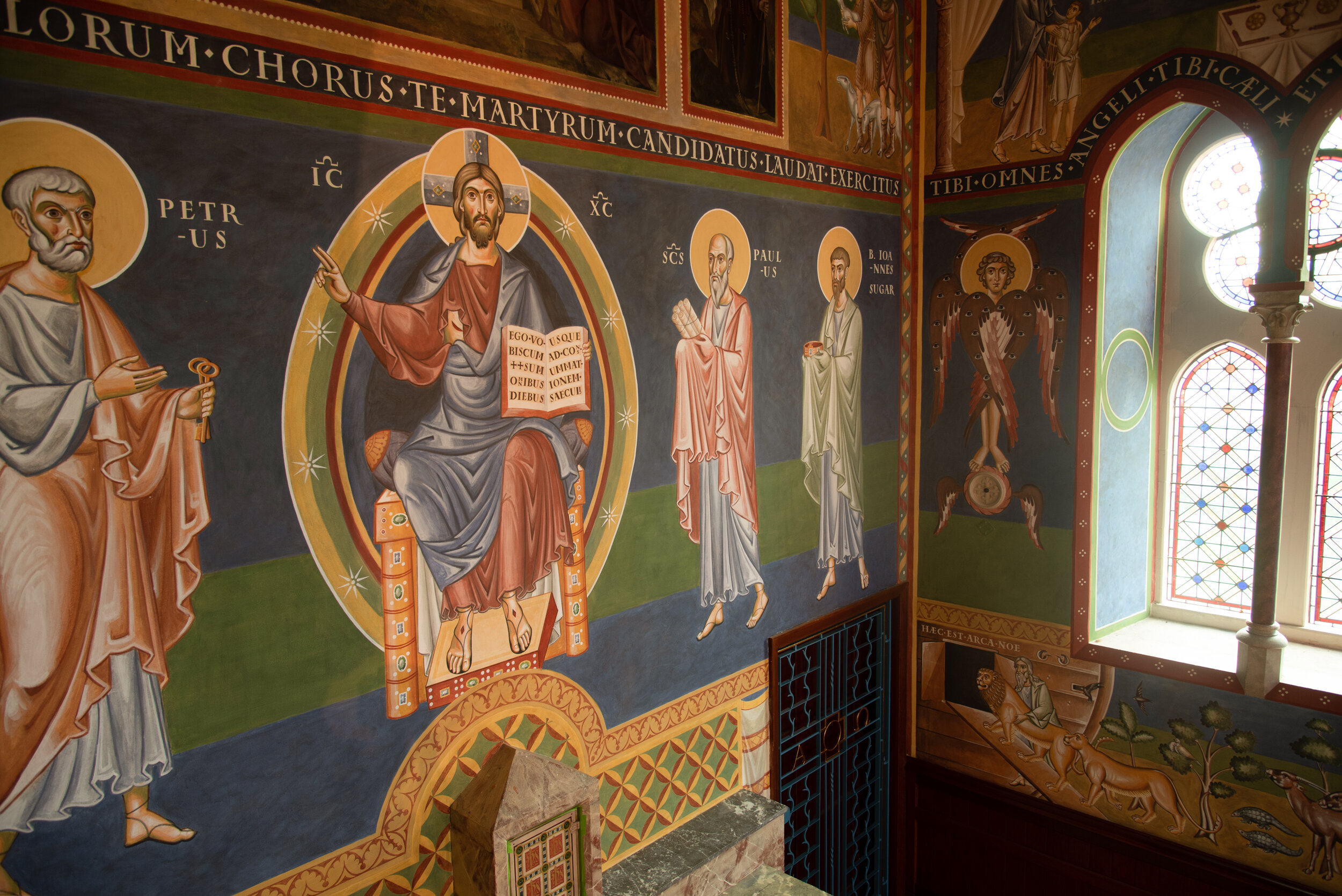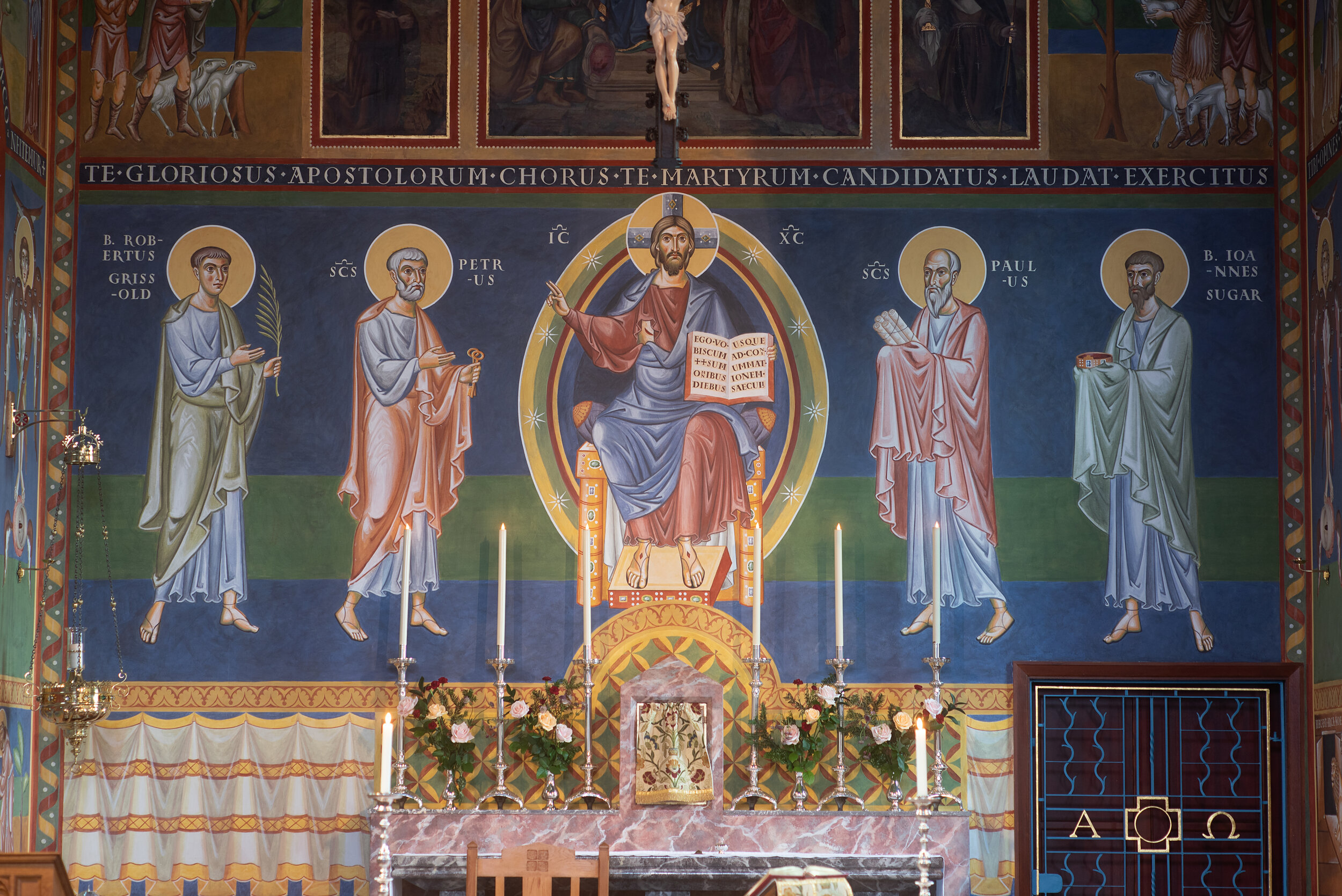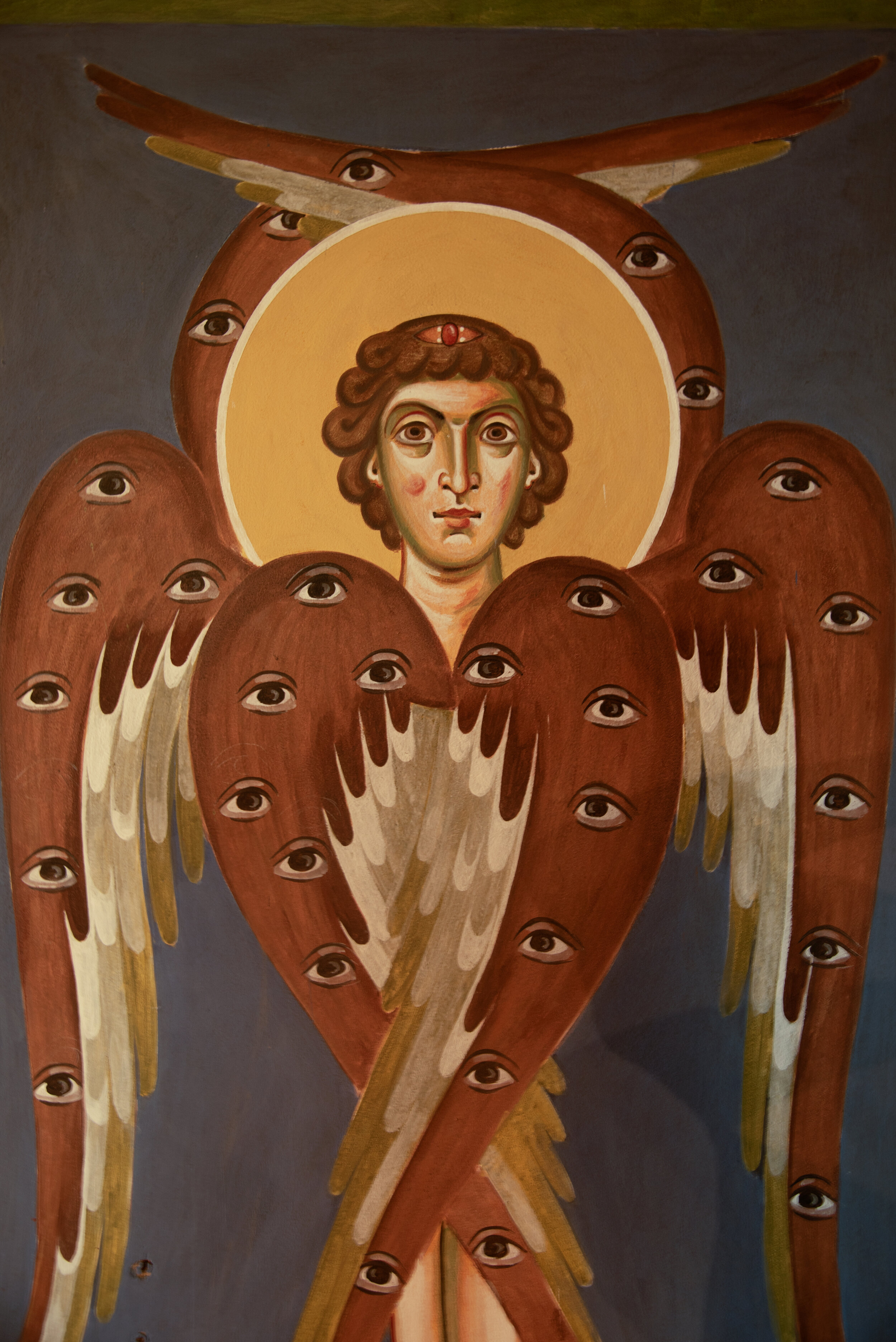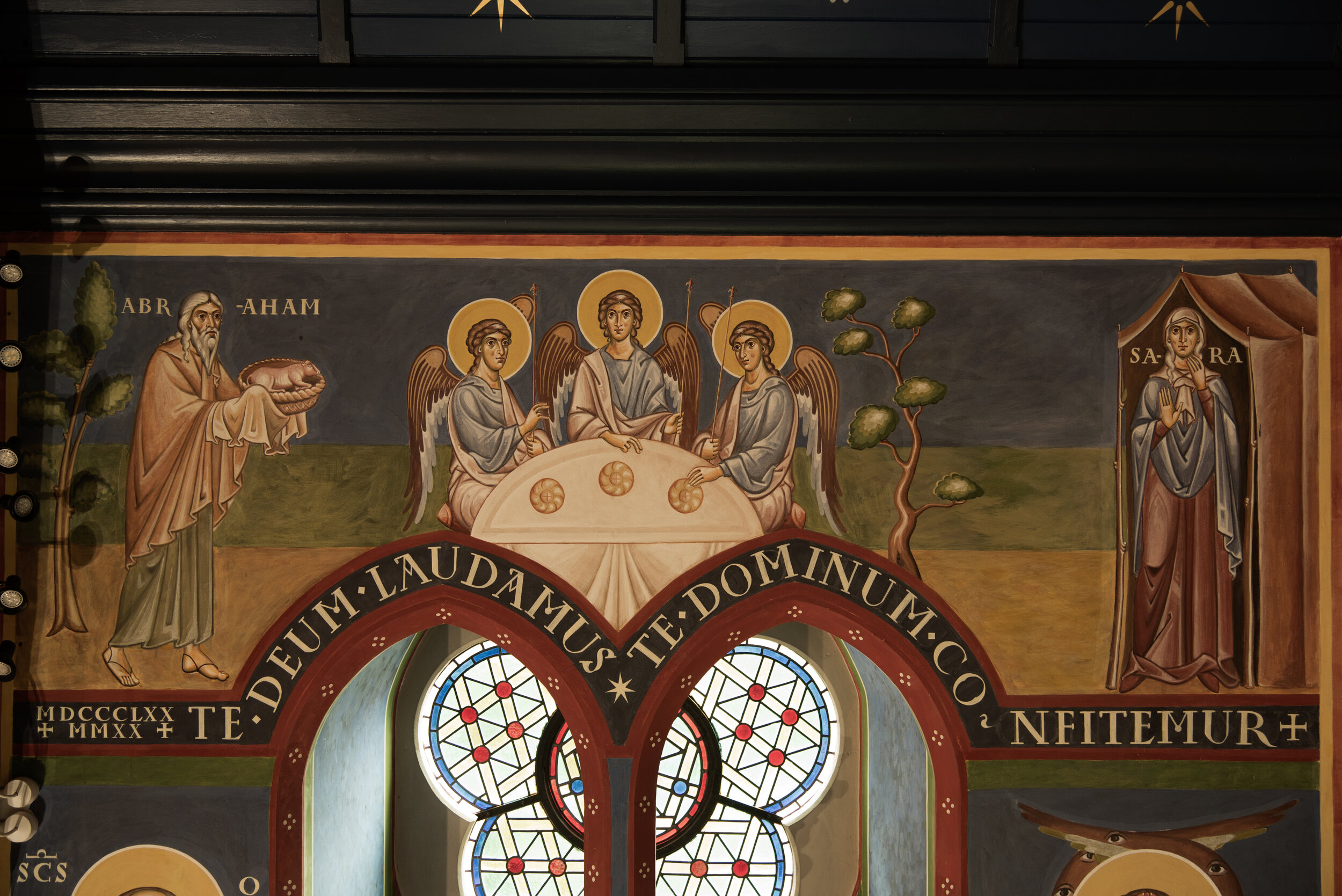Last week I posted images of the spectacular frescoes at St Francis of Assisi Catholic Church in Baddesley Clinton in Warwickshire, in the West Midlands, England. Once again the artist is Martin Earle.
This week I want to post the description of the schema written by the parish priest, Fr John Sharp. Typically, the art in Catholic churches today does not conform to a liturgical schema. Going back, perhaps as much as 200 years (from what I have seen), even when the art is beautiful and of high quality, it is as likely to be a collection of art of the favorite devotions of past priests than what it ought to be, a single, harmonious presentation that reveals the mysteries being celebrated.
I present the document with the introduction and the three sections as written. I have a large number of photographs to show you, and so while I will provide photographs for the first two sections this week. I will provide photos of the third section in a third and final post, next week.
The introductory paragraphs, which come before the description of the paintings themselves, make an excellent basis for a statement of governing principles for devising a schema in any church. The text that follows is by Fr Sharp:
St Francis of Assisi, Baddesley Clinton: The Iconographic Scheme
Sacrosanctum Concilium, the Constitution on the Sacred Liturgy of the Second Vatican Council, paragraph 8, states:
In the earthly liturgy we take part in a foretaste of that heavenly liturgy which is celebrated in the Holy City of Jerusalem towards which we journey as pilgrims, where Christ is sitting at the right hand of God, Minister of the holies and of the true tabernacle. With all the warriors of the heavenly army we sing a hymn of glory to the Lord; venerating the memory of the saints, we hope for some part and fellowship with them; we eagerly await the Saviour, Our Lord Jesus Christ, until he our life shall appear and we too will appear with him in glory.
The scheme of decoration in the sanctuary gives visual expression to this.
The whole schema encompasses salvation history – the preparation of Israel in the Old Testament (past), the First Coming of Christ in the Incarnation and in His continuing Sacramental Presence (present), and His Second Coming at the consummation of all things (future).
EAST WALL
On the east wall, above the tabernacle where He dwells sacramentally in His risen and glorified body, is a representation of Christ in glory, holding in His left hand the Book of the Gospels with the words from the end of Matthew’s Gospel (28:20): ‘I am with you always, to the close of the age’, while His right hand is raised in blessing. He is flanked by St Peter and St Paul, founders of the Church of Rome. Their presence is an historical allusion to the paintings of these saints by Rebecca Dering which formerly were in these positions before being removed in the 1960s. They are flanked by our two local martyrs, Blessed John Sugar and Blessed Robert Grissold, who were captured in the lane near Baddesley Clinton Hall on 8th July 1603 and executed in Warwick on 16th July 1604. They, of course, were martyred for their adherence to the Roman Church.
The frieze above here contains the text of the liturgical hymn Te Deum Laudamus [We praise you, O God], which refers to the ‘the glorious band of apostles … the white-robed army of martyrs all sing your praise’. The text of the hymn begins on the north wall and is preceded by the dates 1870 and 2020 in Roman numerals. 1870 is the date of the opening of the church and 2020 is the date of the painting scheme and the renovation of the church.
Above this frieze, the surviving painting of the Adoration of the Magi by Rebecca Dering is incorporated into a fuller scheme of the Nativity of Our Lord with a representation of the appearance of the angels to the shepherds. These are shown offering lambs to the Lord, mirroring the offering of the gifts by the magi. This evokes the theme of offering, which is continued in the top band of decoration on the north and south walls. Above this scene is the Hand of God, shown in blessing, which applies both to the First and the Second Comings of Christ, both of which are displayed below. The stars of the firmament are carried over to the ceiling of the sanctuary.
NORTH AND SOUTH WALLS
On both the north and south walls are Seraphim, one of the nine choirs of angels. In Scripture, seraphim attend on the throne of God, crying ‘holy, holy, holy’ (Isaiah 6:2-3). Their presence here evokes their role and, again, links the heavenly and earthly liturgy. A seraph also appeared to St Francis at his stigmata, so there is another theme to their presence. They incorporate the two consecration crosses in the sanctuary, all twelve of which around the walls of the church remind us of the twelve apostles and the apostolic faith upon which not just the church building but the Universal Church is built.
On both the south and north walls, above the windows, are biblical scenes of offerings from the Old Testament. On the north wall are the three angelic visitors (symbolising the Blessed Trinity) at the Oak of Mamre to whom Abraham and Sarah offered cakes and a calf (Genesis 18:1-15), On the south wall Abel is shown offering the firstling of his flock (Genesis 4:4; cf. Hebrews 11:4), Abraham offers his son Isaac as a sacrifice to the Lord (Genesis 22), and Melchizedek, King of Salem, offers bread and wine (Genesis 14:18). These are all traditionally seen as ‘mystic signs’ of the Eucharistic offering, pointing to the reality of which they are but a foretaste and pale shadow. Indeed, in the Roman Canon (Eucharistic Prayer 1), the offerings of each of them is mentioned as a harbinger of the Eucharistic offering.
St Wulstan (c.1008-1095) is depicted on the south wall. Born at Long Itchington in Warwickshire, he became Bishop of Worcester and is commemorated in the diocesan calendar with the rank of a Feast. His presence is a reminder that Baddesley Clinton was in the diocese of Worcester, and as the only bishop to have continued in office after the Norman Conquest, he symbolises the continuity of the faith here, embracing the Catholic Church from its first introduction to these isles down through history to our own time.
Opposite St Wulstan is St Nicholas Owen (c.1550-1606). A carpenter by profession, he built hiding places for priests throughout the country, including at Baddesley Clinton Hall. He died under torture in the Tower of London, refusing to disclose any of the hides. Alongside him are the two sisters, Anne Vaux and Eleanor Brooksby, shown holding a model of Baddesley Clinton Hall, who commissioned Nicholas to build hides in the house during the 1580s, when they rented the property and it became the headquarters of the Jesuit Provincial, Henry Garnet, until the famous raid of 19th October 1591.
On the same north wall, above the wooden panelling, St Francis is shown preaching to the birds. This brings our patron saint into the iconographical scheme, and reminds us that St Francis is the patron saint of ecology and that, as he preached to the natural world, redemption is to extend to the whole of creation.
Opposite, on the south wall, Noah is seen herding the animals into the ark. It both mirrors the ecological scene of St Francis opposite, but also is a tropos, reminding us that the Church is the ark of salvation into which all must be gathered before the end of time. The lettering, ‘Haec est Arca Noe’ [Here is the ark of Noah], is from a commentary on the book of Genesis by St Jerome (c.347-420), which compares the ark to the Church. Among the animals shown are two pangolins, reminding us of the coronavirus pandemic, during which the painting was undertaken.
Having all these saints and patriarchs on the three walls of the sanctuary adds to the impression of the whole sanctuary being encompassed by the heavenly liturgy, present at every celebration of the earthly liturgy. Each of the scenes and figures is enclosed within a decorative border, both to define and separate them.
CHANCEL ARCH
On the chancel arch, the liturgical hymn Gloria in excelcis Deo [Glory to God in the highest] repeats the idea that what is sung in the earthly liturgy echoes the praise of the heavenly liturgy, and the themes of both the First and Second Comings of Christ are both repeated and lead into what is displayed in the sanctuary.
At the apex is the Lord’s Cross, seen as an object of glory and veneration, triumphant, bejewelled and containing the sacred monogram ‘IHS’. Below this, and over the altar, is suspended the crucifix, akin to the Rood in medieval churches, suspended between earth and heaven, the point of entry from one to the other, and contrasting with the triumphant cross above, but also positioned so that, from the nave of the church, Christ in glory on the east wall is seen below it, the bottom of the cross in line with the head of Christ.
Surrounding the cross are angels of the apocalypse, as St John relates in his Revelation, one with a trumpet, the other rolling up the moon and stars; the clouds behind them are red and blue, representing the sunrise at the end of time. The same clouds are repeated on the east wall, surrounding the Hand of God, showing that he is Lord of time and of history.
On the spandrels of the arch are stylised representations of Bethlehem and Jerusalem, the two poles of salvation of Incarnation and Redemption, with sheep representing the apostles who continue the saving work of Christ. Jerusalem, of course, is not just an evocation of the earthly city, but also of the heavenly Jerusalem, described in the liturgy of All Saints and in the Dedication of a Church as ‘our mother, where the great array of brothers and sisters gives you eternal praise’ and representative of the Church, the Bride of Christ, ‘mother of countless children’.
Beneath these are four Old Testament prophets, holding scrolls that tell of both Comings of Christ, the Second Coming already foreshadowed in the First Coming, which is completed in the Second Coming:
Isaiah 7:14 : ‘Behold the virgin will conceive and bear a son [and shall call his name] Immanuel’,
Malachi 3:1 : ‘The Lord whom you seek will suddenly come to his temple’
Ezekiel 34:12 : ‘I will rescue my sheep [from all the places where they have been scattered] on a day of clouds and thick darkness.
Zechariah 9:9 : ‘Rejoice greatly, O daughter of Jerusalem! Lo, your king comes to you, the Just One and Saviour’.















